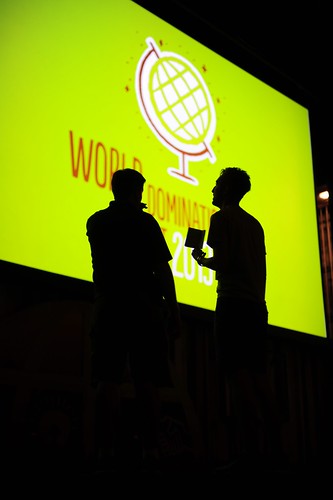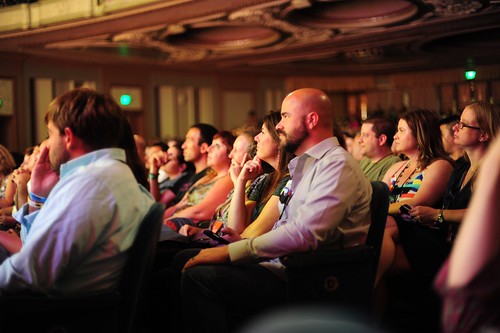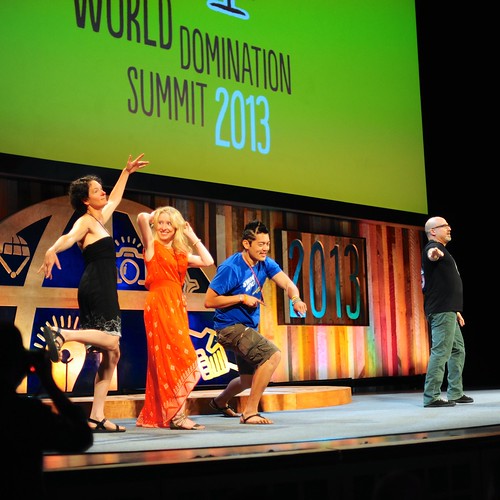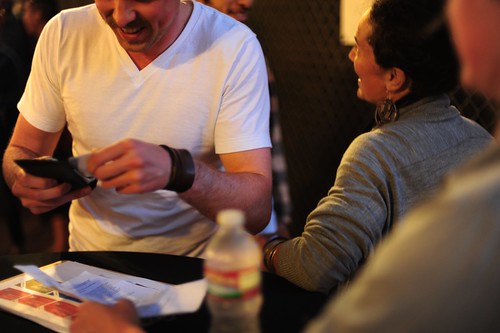Yes, I know I haven’t updated this site in almost a month. To be honest, I haven’t done much of anything for the past few weeks — except work on this year’s World Domination Summit.
Last weekend, we brought nearly 3000 people to Portland to talk about community, service, and adventure. A million-dollar production like this takes a lot of work. More than you can possibly imagine. And so, I’ve been too busy to do anything else.
The hard work is now finished, though, and the conference is over. Our last official meeting about WDS 2013 will take place this evening. From what we can tell, it was a wild success. Beyond our wildest dreams, in fact. (Yes, there were some glitches. But the good stuff far outweighed the glitches.)
There are lost of attendee photos floating around the interwebs, but few from backstage. As I do every year, I carried my camera with me constantly so that I could document things from behind the scenes. Here are a few of my favorite moments from WDS 2013.
As always, my role on the planning team this year was to recruit and co-ordinate speakers. It’s a job I enjoy. It’s fun to create a cohesive arc from ten different presenters.
Every year, I work with a secret sub-theme as we put together the line-up. Last year, the secret them was: “Change yourself, change the world.” This year’s secret them was: “Live your life as a story.” As event organizer Chris Guillebeau and I chose speakers, I looked for folks like Nancy Duarte, people whose messages are clearly about story. I also looked for people with compelling stories to tell. And, when our line-up was set, I asked speakers to consider how their talks might be integrated into this unofficial theme.

Problogger Darren Rowse shared his childhood dream to become Superman.
Backstage, Jolie Guillebeau helped him make that dream come true.

Journalist Tess Vigeland told her raw, personal story on stage. Here, she steels herself for her talk.
Among the glitches this year was the fact we underestimated demand for workshops. Our attendees put together a lot of amazing unofficial events over the course of the weekend, and we thought they’d draw more folks. We were wrong. As a result, workshops were overcrowded and we had to turn people away.
This year, I partnered with Leo from Zen Habits to create a workshop on overcoming fear and building confidence. We had a great time planning it, and thought we were well-prepared for our 150-person venue. We printed 200 handouts just to be safe. But when far more than 200 folks showed up to hear us (we think there were about 250), we had to improvise on the spot. We did the best we could given the situation, but we had to scrap much of our planned presentation.
After the conference was over, we held a massive dance party in Portland’s Pioneer Courthouse Square. As he has every year, DJ Prashant taught attendees Bollywood dancing.
My favorite story from backstage this weekend: When the event was over, as the after-party started, I hosted a dinner for the speakers. I was joined by WDS planning team member (and friend) Tyler Tervooren. After dinner, we walked to the dance party. Unfortunately, Tyler had lost his nametag, which was required to enter the square.
“But I’m one of the organizers,” Tyler said.
“It doesn’t matter,” the woman guarding the entry said.
“Really?” I said. “I can vouch for him. He’s been planning this for months.”
“I’m sorry,” she said.
Tyler seemed stumped for a moment, but I could see the gears working in his head. “How about this?” he said at last, as he fished in his pocket. “This piece of paper is the event-use permit for this party. It’s the document I had to sign with the city to rent this park. That’s my signature. Here’s my driver license to verify it.”
The woman laughed. “Okay,” she said. “You can go in.”
The best part of World Domination Summit is meeting the attendees. The people who come to this event are amazing. Unfortunately, I have less time to do that each year. This year, I managed to have dinner with attendees on Saturday night. I also spent most of Monday and Tuesday meeting with folks too. (I particularly enjoyed dinner on Monday night. Kim and I joined speakers Tess Vigeland and Jia Jiang as well as some close blogging colleagues. We had a great meal and a great conversation.)
Now, I’m tired. Producing WDS 2013 took a lot out of me this year, physically and mentally and emotionally. I’m drained. It’s been two or three months since I’ve had time to work on my own projects. (As I mentioned already, it’s been an entire month since I had time to even update this site.) I love World Domination Summit, and I’d love to be a part of it in the future. But I’m not sure it’s worth the sacrifices I’ve had to make. After all, you have to dominate your own life before you can dominate the world.

































